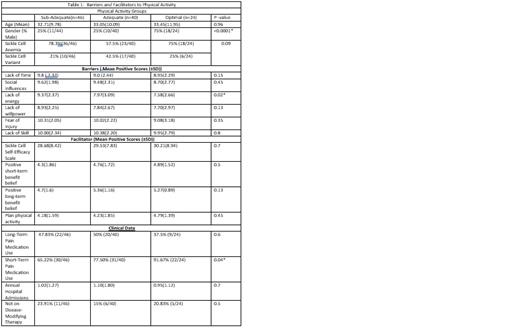Abstract
Cardiopulmonary disease is a leading cause of death for adults with sickle cell disease (SCD) and targeted therapies to modify cardiopulmonary disease currently do not exist. Physical fitness is an important predictor of cardiovascular morbidity and overall survival. More specifically, individuals who have lower fitness are at a higher risk for poor cardiovascular outcomes and premature death. Previous studies show that adults with SCD have lower physical fitness levels compared to the general population and deconditioning is one of the reasons cited for lower fitness in SCD. Fortunately, increasing physical activity can improve physical fitness and can result in better daily functioning, disease-related symptomatology, and cardiovascular outcomes in other chronic disease populations. Thus, evaluating the amount of physical activity in SCD provides an excellent opportunity to explore strategies to improve physical fitness which could have larger implications to cardiovascular health in SCD. The objective of this study is to determine physical activity levels in addition to identifying barriers, facilitators, and attitudes towards physical activity in an adult population with SCD.
Methods: We obtained consent from 110 ambulatory adults with SCD (age=19-68 yrs; 69% female; 77% HbSS) during routine visits at an adult comprehensive sickle cell center. Participants completed validated quantitative assessments (International Physical Activity Questionnaire, CDC Barriers to Exercise Survey, and Determinants of Physical Activity) to determine weekly physical activity levels and to identify barriers, facilitators, and attitudes towards physical activity. High self-efficacy is a marker of resilience to sustaining physical activity, so we evaluated self-efficacy using a scale tailored to SCD, the Sickle Cell Self-Efficacy Scale. Information regarding genotype, gender, age, pain medication use, disease-modifying therapy, hospital admissions, and acute care visits were obtained from the electronic medical record. Physical activity levels were stratified into three groups: (1) sub-adequate( < 3 days of low to moderate-intensity exercise), (2) adequate(3 days of moderate-intensity activity or > 4 days of low-intensity activity), and (3) optimal ( ≥4 days of moderate-intensity activity). We compared proportions across the three groups using chi-square analysis. To compare scales across the three groups, we used the non-parametric Kruskal-Wallis test.
Results: 94 completed entries and 16 partial entries were analyzed at the conclusion of the study. Only 21.8% (n=24) of the participants reported optimal levels of physical activity. There were more males in the optimal activity group (N=18/24, p=<0.0001) compared to the other groups, but there was not a significant difference between genotype and age among the three groups. Among the barriers evaluated, lacking energy was identified more often in the sub-adequate group compared to the other two (Table 1). Other important barriers to physical activity such as lack of time, social influence, and so forth were identified more often in the sub-adequate group than the optimal group but this was not statistically significant (Table 1). Facilitators to physical activity and self-efficacy scores did not differ tremendously between the three groups. Interestingly, participants in the optimal sub-category were more likely to use short-acting pain medications compared to the other groups (Table 1). However, there were no significant differences between use of long-acting pain medications, the use of disease-modifying therapy, and hospital admissions among the physical activity groups.
Limitations: The quantitative surveys were validated in the general population which may not include the needs specific to SCD. Self-reported physical activity levels are subjective and consequently subjected to recall bias.
Conclusion: This is the first report of physical activity levels in US adults with SCD. The majority of SCD participants reported sub-optimal levels of activity and currently do not meet the national guidelines of physical activity in the US. This study underscores the importance of implementing strategies such as regular exercise to increase physical activity in SCD. Gender-differences in physical activity, pain medication use, and fatigue as barriers and facilitators to physical activity will need to be studied further.
Ogunsile: Global Blood Therapeutics: Consultancy, Other: Disease-Specific Presentations on SCD; Clearview Research Institute: Consultancy, Honoraria; Novartis: Consultancy, Other: Treatment-Specific Therapy on Crizanlizumab ; Forma: Consultancy, Other: Attended one Advisory Board Meeting . Lebensburger: Novartis: Consultancy; Bio Products Laboratory: Consultancy. Kanter: Fulcrum Therapeutics, Inc.: Consultancy; Novartis: Consultancy, Honoraria, Membership on an entity's Board of Directors or advisory committees; Forma: Consultancy, Honoraria, Membership on an entity's Board of Directors or advisory committees; Agios: Honoraria, Membership on an entity's Board of Directors or advisory committees; Beam: Honoraria, Membership on an entity's Board of Directors or advisory committees; Sanofi: Honoraria, Membership on an entity's Board of Directors or advisory committees; Graphite Bio: Consultancy; GuidePoint Global: Honoraria; Fulcrum Tx: Consultancy.


This feature is available to Subscribers Only
Sign In or Create an Account Close Modal